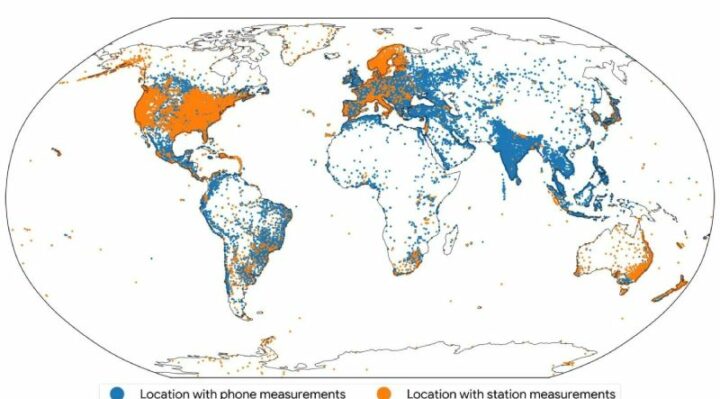
That common smartphone you carry around might be an effective instrument for space exploration. Researchers from Google and CU Boulder have created one of the most comprehensive maps of the topmost layer of Earth’s atmosphere to date by turning millions of Android phones worldwide into a fleet of agile scientific tools.
The group’s discoveries, which were published on Nov. 13 in the journal Nature, could contribute to a multiplication in the accuracy of GPS technology globally. Professor Jade Morton of CU Boulder’s Ann and H.J. Smead Department of Aerospace Engineering Sciences participated in the study, which was headed by Brian Williams of Google Research.
Morton remarked, “These phones can literally fit in your palm,” “But through crowdsourcing, we can use them to change the way we understand the space environment.”
She and her colleagues gathered information on how Earth’s atmosphere distorted satellite signals using the GPS sensors that are built into all smartphones. As a result, they were able to observe atmospheric phenomena in hitherto unobserved detail, including “plasma bubbles,” which are blobs located high above the earth.
In order for everyone to observe how the atmosphere changed and swirled over around eight months, the group made its data publicly available. Lizzie Dorfman, product lead for Science AI at Google Research, stated that “collaboration is central to scientific progress and to our scientific research at Google.” “Dr. Morton’s expertise was essential to this research, and it has been an absolute pleasure working with her as a visiting researcher and collaborator.”
Observe the ionosphere
More than 350 miles above the surface of the earth, the ionosphere is a thin layer of the atmosphere that is the subject of this study.
It is a volatile environment: The sun’s rays continuously strike the atmosphere, causing its molecules and atoms to split into a soupy mixture of charged particles known to scientists as plasma. It never remains motionless either.
“At 2 o’clock in afternoon, there are a lot more charged particles in the ionosphere because the sun is at its strongest,” Morton explained. “But at night, the sun is on the other side of the planet, so we have very few charged particles.”
When it comes to GPS technology, that variation can be disastrous.
According to Morton, satellites located hundreds of miles away from Earth send radio waves to the globe, which serves as a kind of stopwatch in space. Then, by timing the time it takes for those signals to reach the ground, your phone determines your exact location.
By employing ground-based radar dishes to monitor this area of space, scientists attempt to take into consideration how the ionosphere might alter that timing. But as of right now, they can only see only 14% of the ionosphere at once. Because of this, your precise location may be a few to several dozen feet off from what GPS systems detect.
“There are a lot of applications that require a lot of accuracy—for example, landing aircraft,” said Morton.
Bubbling up
The researchers in the current study came up with an unconventional idea: instead of utilizing pricey radar dishes, they could monitor the ionosphere using a set of sensors that are currently present in every nation on the planet: Android phones.
Combined measurements of radio waves between satellites and the receivers in certain Android devices are used to construct the ionosphere maps. Privacy safeguards make guarantee that no contributing devices are identified by these measurements.
Specifically, the team utilized the phones to monitor in real time how radio waves from satellites are reflected by the ionosphere.
According to the team, this global fleet could independently observe around 21% of the ionosphere, which could double the accuracy of GPS units globally.
“Millions of phones together can do a much better job of monitoring the atmosphere than our ground network,” Morton stated.
The ionosphere is also brilliantly detailed in the group’s maps.
In May 2024, for instance, the group’s cell phones were staring skyward as a strong solar storm hit Earth. Large areas of atmosphere, known as “plasma bubbles,” with modest concentrations of charged particles developed over portions of South America in the hours that followed. Like wax in a lava lamp, those bubbles then arose through the ionosphere.
According to Morton, the study demonstrates the unrealized potential of commonplace technologies that are often taken for granted.
“I have spent my lifetime building dedicated instruments to do scientific research,” Morton stated. “But as technology advances in our society, we see all these sensors at our disposal that have a lot more power than we ever imagined.””I have spent my lifetime building dedicated instruments to do scientific research,” Morton stated. “But as technology advances in our society, we see all these sensors at our disposal that have a lot more power than we ever imagined.”



